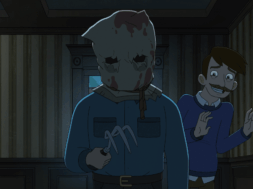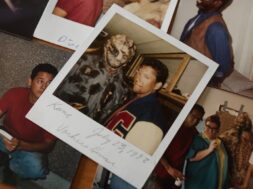Henry James is a literary great who’d developed a reputation for penning atmospheric and emotionally gripping ghost stories. Though he’d written many, his most famous by far is his 1898 novella The Turn of the Screw. James preferred style was unconventional, supernatural hauntings that were extensions of reality. The haunting at Bly Manor was steeped in ambiguity, so much so that it remains wide open for many different interpretations. This is why the novella has been the subject of numerous adaptations over the years. 2020 offers two varying takes alone; The Turning and Netflix’s The Haunting of Bly Manor. So far, Jack Clayton’s The Innocents remains the gold standard of adaptations, though.
Opening on Christmas Eve, as many classic ghost stories do, an unknown narrator listens to a friend read a manuscript from a former governess. He provides introductory details before diving into the reading; a handsome and wealthy bachelor is the guardian of his orphaned niece and nephew but prefers to leave them in the care of a governess so he can continue his bachelor lifestyle away from the country home. When the previous governess dies, he hires an attractive but unqualified woman — the narrative shifts to the new governess’s point of view as she relays her eerie tale.
The governess is immediately smitten by the youngest child, Flora, and bonds with the maid Mrs. Grose. Flora’s brother, Miles, returns home soon after due to school expulsion under mysterious circumstances. It coincides with the governess seeing apparitions of a man and woman, separately, on the grounds of the country estate — the ghosts of the former governess, Miss Jessel, and Quint, a former valet. Frightened by their appearances, the governess surmises the spirits are after the children, who’ve been behaving strangely. Fearing they’re being possessed, she’s determined to save their souls.

There’s nothing straightforward about the narrative. The ending is abrupt and without a concise explanation. James keeps things intentionally vague and enigmatic, and one of the most common reads is that the governess is an unreliable narrator crumbling under the weight of her repressed sexuality. That the ghosts, manifestations of her delicate state of mind, represent unrestrained sexuality. The Innocents makes the subtext of these themes much more explicit.
From the outset, director Jack Clayton (Something Wicked This Way Comes) and writers William Archibald and Truman Capote paint the governess, Miss Giddens (Deborah Kerr), as fearful and delicate. She’s overwhelmed and worried when her employer, the bachelor uncle, leaves her to her duties with instructions that she has supreme authority; and to never bother him at all. While James’ novella implied a creepy sexual attraction between Miles and Miss Giddens, Clayton makes it more overt. Though filmed with stunning gothic style, and delivering one of horror’s greatest scares via ghostly encounter, it’s clear that we’re meant to question Miss Giddens’ fragile mind. The more the ghosts of Bly Manor’s past appear, the more frenzied she becomes.

The fragile mind is a common motif in horror. Alfred Hitchcock’s Rebecca followed a woman struggling to adjust to life as a newlywed, finding herself haunted by her husband’s previous wife. It was an adaptation of Daphne du Maurier’s novel of the same name, with a modern update heading to Netflix sometime this year. Just four years after the release of The Innocents, Roman Polanski made his debut with Repulsion, which centers around a woman so repulsed by sexuality that she’s driven to hallucinogenic madness. In between the two was The Haunting, a classic horror film that saw its lead, Nell (Julie Harris), susceptible to the ghosts of Hill House due to her psychological fragility.
Poor Jessica checks out of a mental hospital, only for voices and apparitions to call her sanity into question once more in Let’s Scare Jessica to Death. The Entity, though not subtle in the least, saw a woman being sexually tormented by an unseen demon, causing her soundness of mind to come into question by everyone around her. More recently, a single mother drowning in grief saw her fragile state of mind manifest a physical haunting in the form of The Babadook.
The nature of this type of horror, of haunted heroines with fragile minds, presents a psychological element that sets up a central driving mystery; is it all in the narrator’s mind, or is there a supernatural presence? More importantly, it’s the core foundation to build upon what horror does best, which is to reflect our current societal or personal fears. For James’ novella, it’s been speculated that the themes of repressed sexuality possibly reflected the author’s repressed attraction to men. In The Haunting, Nell was susceptible to Hill House because of her isolation in caring for an oppressive and invalid mother. Something that caused her to suppress her thoughts, dreams, and desires.

Horror’s exploration of the fragile mind, especially in the case of James’ novella, makes for a blank canvas ripe for reinterpretation again and again. We can expect Mike Flanagan to take loose artistic liberties with The Turn of the Screw for Bly Manor, as he did with Shirley Jackson’s source material for The Haunting of Hill House. What’s less clear is how Floria Sigismondi will approach the source material for The Turning. The choice to set the film in the ‘90s is an interesting one. Will this be a straight forward supernatural haunting? Or an unraveling psychosis of Mackenzie Davis’ lead character?
The interesting thing about James’ original story is that it can go anywhere.









